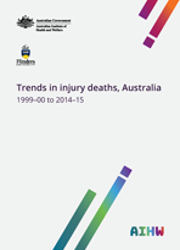Summary
This report describes trends in the occurrence of injury deaths in Australia from 1 July 1999 to 30 June 2015 and provides a summary of injury deaths in 2014–15. The information is based on all causes of death recorded on death certificates.
Injury deaths in 2014–15
Injury was recorded as a cause of 12,647 deaths in 2014–15 in Australia, corresponding to an age-standardised rate of 48 deaths per 100,000 population (males 64, females 33).
Rates were highest in the oldest age group: 196 and 183 per 100,000 for men and women aged 65 and older. Rates for males were much higher than for females except in children aged 0–4 and those aged 65 and over. At ages 15–24, the rates for males and females were 35 and 15 per 100,000, respectively.
The age-standardised injury death rate for residents of the Northern Territory—85 deaths per 100,000 population—was 1.8 times the national rate. The age-standardised injury death rate increased with increasing remoteness of place of residence: the rate for residents of Remote areas (88 deaths per 100,000) was more than 2 times the rate for residents of Major cities
(43 per 100,000). The age-standardised rate of injury death also increased with socioeconomic disadvantage. The rate for residents in areas classified as Most disadvantaged areas was 1.4 times the rate for residents in areas classified as Least disadvantaged.
The 2 main causes of injury deaths in 2014–15 were Unintentional falls (37%; 4,718 deaths) and Suicide (23%, 2,926 deaths). Almost 95% (4,465) of fall-related injury deaths occurred at ages 65 and older. There were 3.2 times as many male suicides (2,226) as female (700).
Trends in injury deaths
The age-standardised rate of injury deaths decreased from 55.4 deaths per 100,000 in 1999–00 to 47.2 deaths per 100,000 in 2004–05 and changed little after that. The number of injury deaths varied, but was around 10,000 per year during this period.
Rates of injury deaths declined from 1999–00 to 2014–15, by an average of 3.9% per year for transport-related injury, 2.8% for drowning and 2.6% for homicide. Rates of poisoning deaths involving pharmaceuticals fell sharply to 2001–02, then rose to 2014–15, particularly for men and women in the 45–64 age group. Rates of fall-related injury deaths, poisoning deaths involving substances other than pharmaceuticals and thermal-related injury deaths did not show a significant trend, despite a large peak in thermal injury deaths in 2008–09.
Analysis of changes in rates over time for some causes of injury was complicated, due to changes in the way that causes have been recorded and classified over recent years.
Trends in injury deaths of Indigenous Australians
Age-standardised injury death rates for Aboriginal and Torres Strait Islander people fluctuated, but did not change significantly over the period from 2001–02 to 2014–15. Rates declined for transport injury and rose for cases involving pharmaceuticals. Rates for Aboriginal and Torres Strait Islander people were generally at least twice as high as rates for non-Indigenous Australians over this period.
Summary
1. Introduction
2. Overview of injury deaths
3. Transport crashes
4. Drowning
5. Poisoning, pharmaceuticals
6. Poisoning, other substances
7. Falls
8. Thermal injury
9. Other unintentional injury
10. Suicide deaths
11. Homicide deaths
Appendix A: Data information and issues
Appendix B: Transport deaths: motor vehicle traffic
Appendix C: Injury death counts by reference year and ABS release
End matter: Acknowledgments; Abbreviations; Symbols; Glossary; References; List of tables; List of figures



